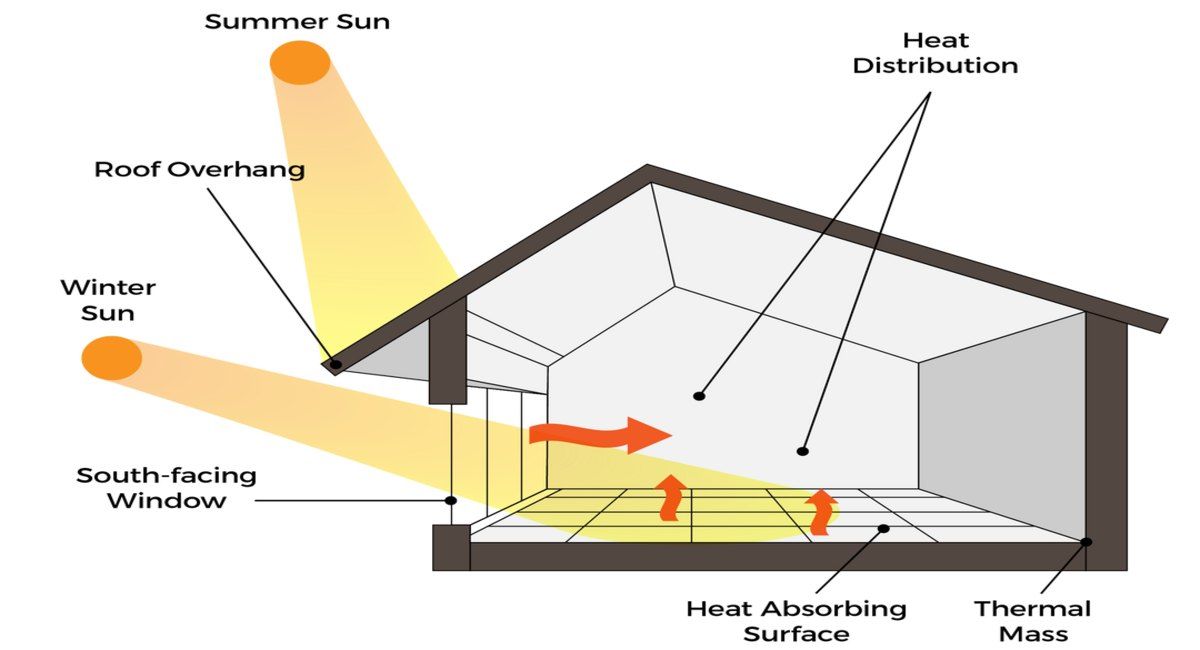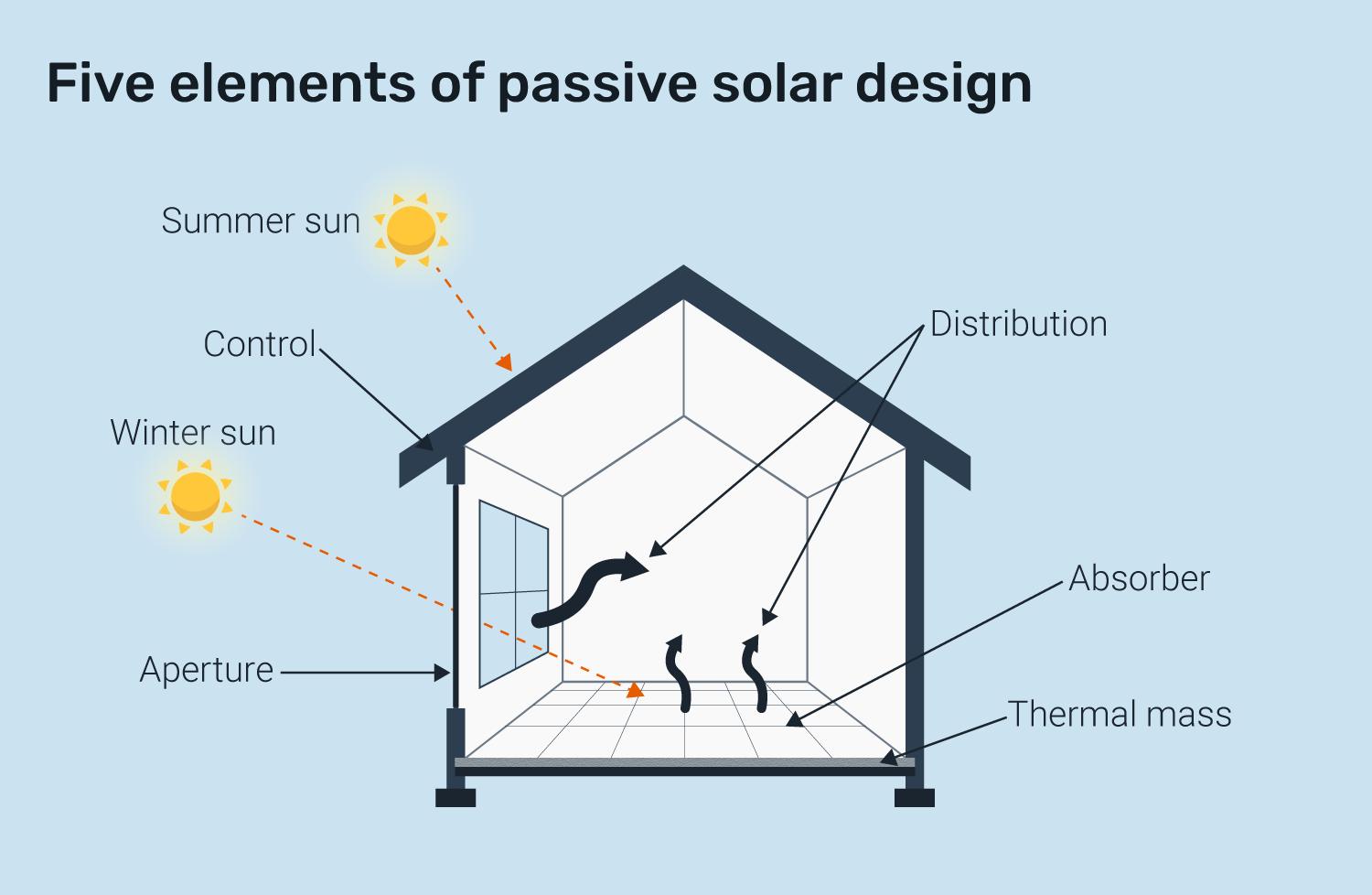Key Features Of Passive Solar Design For Single-Family Homes?

What Is Passive Solar Design?
Passive solar design is the use of the sun's energy to heat and cool living areas by exposing them to the sun. When sunlight reaches a structure, the materials used to construct it can either reflect, transmit, or absorb the solar energy. Furthermore, the heat created by the sun generates air movement, which may be predicted in well-designed areas. These fundamental reactions to solar heat result in architectural features, material selections, and placements that can have heating and cooling effects in a home. Passive solar heating systems, in contrast to active solar heating systems, are simple and do not rely heavily on mechanical and electrical equipment to transport the solar energy, such as pumps, fans, or electrical controllers.
In passive solar building design, windows, walls, and floors are designed to absorb, store, reflect, and distribute solar energy in the form of heat in the winter and reject solar heat in the summer. This is known as passive solar design
The key to developing a passive solar building is to take full advantage of the local environment by conducting a thorough site survey and a virtual analysis through solar software. Window placement and size, as well as glass type, thermal insulation, thermal mass, and shading, are all factors to consider. Passive solar design principles are most easily applied to new structures, although older buildings can be altered.
What Is the Principle for Passive Solar Design?
Passive solar design technologies take advantage of sunshine without the use of active mechanical devices (as contrasted to active solar, which uses thermal collectors). Such technologies turn sunlight into usable heat (in water, air, and thermal mass), causing air movement for ventilation or future usage while consuming few additional energy sources. A solarium on a building's equator side is a popular example. Passive cooling is the application of comparable design ideas to decrease summer cooling needs.
Some passive systems employ a tiny amount of conventional energy to regulate dampers, shutters, night insulation, and other devices that improve solar energy collection, storage, and use while reducing unwanted heat transfer.
Passive solar technologies include direct and indirect solar gain for space heating, thermosiphon-based solar water heating systems, the use of thermal mass and phase-change materials to slow indoor air temperature swings, solar cookers, the solar chimney for enhancing natural ventilation, and earth sheltering.
Solar technologies include the solar furnace. However, this often requires some other energy for orienting their focusing mirrors or receivers, and has traditionally not proven to be practical or cost-effective for widespread usage. "Low-grade" energy demands, such as space and water heating, have been shown to be superior applications for passive solar energy utilization over time.
The Science Behind Passive Solar Design:
The scientific basis for passive solar building design is based on a combination of climatology, thermodynamics (particularly heat transfer: conduction (heat), convection, and electromagnetic radiation), fluid mechanics/natural convection (passive movement of air and water without the use of electricity, fans, or pumps), and human thermal comfort based on heat index, psychrometrics, and enthalpy control for buildings to be inhabited by humans or animals; sunroofing.
The following aspects are given special consideration: the building's site, location, and solar orientation; the local sun path; the prevailing level of insolation (latitude/sunshine/clouds/precipitation); design and construction quality and materials; window and wall placement/size/type; and incorporation of solar-energy-storing thermal mass with heat capacity.
While these concerns may be applied to any structure, getting an optimal cost-performance solution necessitates thorough, holistic, system integration engineering of these scientific concepts. Modern refinements through computer modeling (such as the comprehensive U.S. Department of Energy "Energy Plus" building energy simulation software) and the application of decades of lessons learned (since the 1970s energy crisis) can achieve significant energy savings and environmental damage reduction without sacrificing functionality or aesthetics. In reality, passive-solar design elements such as a greenhouse, sunroom, or solarium may significantly improve a home's usability, sunshine, vistas, and value at a cheap cost per unit of area.
Since the 1970s energy crisis, much has been learnt about passive solar building design. Many costly, illogical, intuition-based building initiatives have sought and failed to reach zero energy — the complete removal of heating and cooling energy expenditures.
Although passive solar building construction is not difficult or expensive (using off-the-shelf existing materials and technology), scientific passive solar building design is a non-trivial engineering effort that necessitates significant study of previous counter-intuitive lessons learned, as well as time to enter, evaluate, and iteratively refine the simulation input and output.
The use of thermography with digital thermal imaging cameras for a formal, quantitative scientific energy audit has been one of the most beneficial post-construction evaluation techniques. Thermal imaging can be used to document poor thermal performance locations, such as the negative thermal impact of roof-angled glass or a skylight on a chilly winter night or a hot summer day.
The scientific insights learned over the previous three decades have been encoded in sophisticated computer software systems for complete building energy modeling (like U.S. DOE Energy Plus).
A beginner will find it difficult to develop a scientific passive solar building with quantitative cost benefit product optimization. The degree of complexity has resulted in continued poor architecture and numerous intuition-based, unscientific building experiments that disappoint their designers and spend a considerable portion of their construction budget on incorrect concepts.
What Are The 5 Main Elements Passive Solar Design?

Collector:
The wide glass space that allows sunshine to enter the structure. During the heating season, the aperture(s) should face within 30 degrees of true south and should not be shadowed by other buildings or trees from 9 a.m. to 3 p.m. everyday.
Absorber:
The storage element's rough, black surface. The surface, which might be a stone wall, floor, or water container, is directly in the path of the sun. Heat is absorbed as a result of sunlight striking the surface.
Thermal Mass:
Materials that absorb or store the heat generated by sunshine. The thermal mass is the substance beneath and behind the absorber, which is an exposed surface.
Distribution:
The process through which solar heat travels from collecting and storage locations to various regions of the home. A purely passive design will rely only on the three natural heat transmission mechanisms of conduction, convection, and radiation. Fans, ducting, and blowers may be used in some applications to transfer heat around the house.
Control:
During the summer, roof overhangs can be employed to shade the aperture area. Electronic sensing systems, such as a differential thermostat that signals a fan to switch on, as well as movable vents and dampers that allow or limit heat flow, low-emissivity blinds, and awnings, are other features that regulate under and/or overheating.
Design, Options, And Cost:

A passive solar home is an exceptional home, differing from standard construction in the thermal integrity of its shell and its well-considered design. The design options, employing the principles and methods described here are endless. However, workmanship is always extremely important when installing insulation, air sealing the building envelope, and installing the windows. Most successful passive solar homes are very airtight. As a result, they may require mechanical ventilation systems to maintain good indoor air quality. Heat-recovery ventilator (HRV) is often the best choice to conserve the home’s hard-won solar heat. An HRV takes heat from the departing indoor air and transfers this heat to the entering outdoor air.
Passive solar technology may still be new to many designers and builders. So you`re sometimes required to pay extra for them to master unfamiliar design and construction details. But if you’re lucky enough to be working with an experienced solar designer and builder who are committed to excellence, a passive solar home may cost no more than a conventional one or even less in some situations. Also, properly sized heating equipment, which are typically smaller in passive solar homes, will sometimes offset the cost of the passive solar features.

